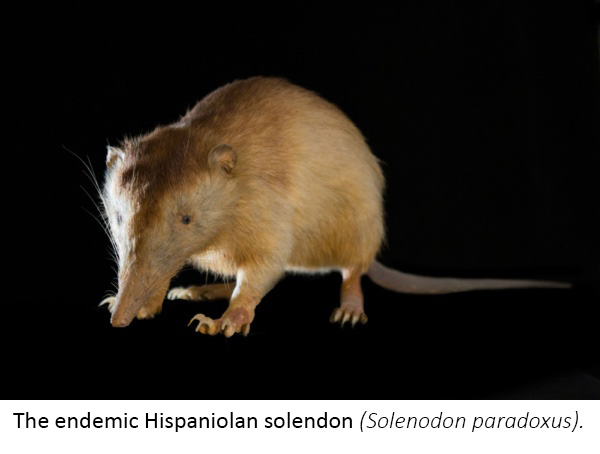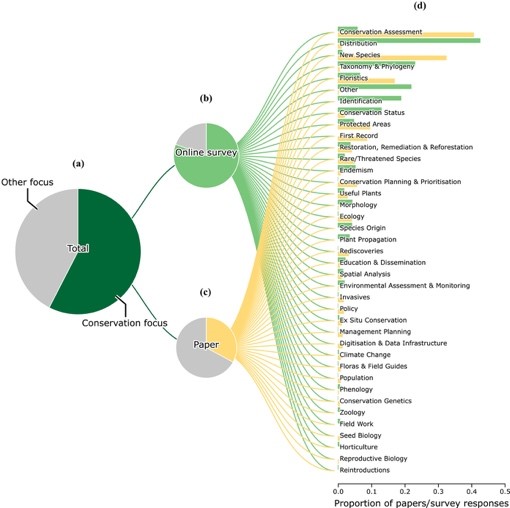Research Spotlight: May 2019
Conservation Focus: New Insights for Conservation from Expansion of Physical‐Collection Digital Data
Libby Ellwood, Pam Soltis, and Mary Klein
Conservation science is a discipline racing against time. Since the science of conservation emerged roughly 40 years ago, one of the things we have learned is that the pressures on biodiversity constantly shift and frequently accelerate over time. In response, conservation biologists have struggled with the challenges of rapidly gathering data on a scale that is sufficient to illuminate how natural systems work, how they are changing, and what those changes mean for the conservation of species and ecosystems.
Among its other side effects, the race to study rapid ecological changes led to an underutilization of data sources that were complex or difficult to access. One of those sources of data is the treasure trove of information represented by specimen collections held by museums and herbaria. Yet there is a tremendous potential for advancing conservation through the greater use of information contained in these collections. Collections data are well‐structured and follow strict guidelines, making them ideal for integration with observational and camera‐trap data, local‐ to landscape‐level data, climate data, observation data, and even behavioral data (e.g., bird calls). And, the specimens themselves provide valuable reference points that enhance understanding of other observations, including the preservation of genetic information and structural traits that aid in species identification as taxonomies are refined.
Today, conservation biologists and biodiversity scientists are actively developing ways to use digitized data from natural history collections in analyses, models, and complex methods. Some of this research would have been impossible only 5 years ago. Here we present a “Conservation Focus” from the journal Conservation Biology, containing 3 articles that demonstrate robust, creative, and timely uses of collections data in conservation.
 Gibson et al. (2019) [1] compiled records of the endemic Hispaniolan solenodon (Solenodon paradoxus) from the fossil record, museum specimens, and recent field work to assess the effects of climate change and human activities on island populations of this at-risk species. Models constructed from these records demonstrate that Solenodons are very unlikely to be present once human density reaches 166 people/km2. The deep time perspective afforded by incorporating fossil and modern collections data allowed the authors to piece together centuries of history. Most importantly, these methods provide insights that can be applied directly to management of the species and its habitat.
Gibson et al. (2019) [1] compiled records of the endemic Hispaniolan solenodon (Solenodon paradoxus) from the fossil record, museum specimens, and recent field work to assess the effects of climate change and human activities on island populations of this at-risk species. Models constructed from these records demonstrate that Solenodons are very unlikely to be present once human density reaches 166 people/km2. The deep time perspective afforded by incorporating fossil and modern collections data allowed the authors to piece together centuries of history. Most importantly, these methods provide insights that can be applied directly to management of the species and its habitat.
Nic Lughadha et al. (2019) [2] demonstrate how digital specimen databases can speed access to the latest data about species undergoing major taxonomic evaluations before monographs are published, which supports more timely conservation research and increases communication between conservation and taxonomic communities. To do this, Nic Lughadha et al. (2019) examined biodiversity records over time and evaluated the extent to which changes and updates to records influenced how those data are reflected in research results. This work not only sheds light on the advantages and utility of online databases for conservation research, but also serves as a call to action for researchers to more fully make use of the features of databases that allow for taxonomic updates, georeferencing, and communication between taxonomists and conservation biologists.
anteiro et al. (2019) [3] evaluated the conservation uses of a rapidly developing digital collections resource in Brazil, Reflora Virtual Herbarium. They show its potential to lead to direct conservation outcomes through research channels that plug into decision‐making processes. The portal focuses on plant specimens from Brazil that historically have been housed in collections around the world. Reflora's aim is to meet the goals of the Global Strategy for Plant Conservation for 2020 (reflora.jbrj.gov.br). Canteiro et al. (2019) share a diversity of research and implementation use cases for Reflora data and demonstrate that many conservation applications are not reflected in published scientific research. Although nonacademic researchers do not always publish their findings in peer‐reviewed journals, their work is critically important for justifying the need for online data repositories, and improvements should be made to capture these studies in accounting of database usage.

Overview of uses of Reflora resources based on a literature review and online survey: proportion of (a) all items, (b) online survey responses, (c) scientific papers with conservation‐relevant uses, and (d) papers and survey responses associated with a particular use.
There is a growing body of literature demonstrating the uses of natural history collections data in biodiversity research (e.g., Meineke et al. 2018 [4]), and the articles here provide fresh examples of how these data provide critical information to address many of conservation's grand challenges, such as evaluating habitat loss; changes in diversity due to climate change, pollution, and other environmental factors; spread of invasive species; and extinction events. This “Conservation Focus” offers new and established conservation scientists information about the most effective ways to work at the intersection of collections and conservation. We recommend researchers view each article's methods as resources to be used to familiarize themselves with collections data, to locate collections data, and to determine how collections data can be applied to conservation challenges. Further, these articles demonstrate the utility of data from natural history collections in providing historical, baseline, long‐term, and cross‐taxa data that are key to assess conservation needs and strategies—elements that inform policy making. Thus, they show policy makers the ready accessibility and conservation uses of collections data.
Text for this post has been modified from the original Introduction article:
Ellwood, E. R., Soltis, P. S. and Klein, M. L. (2019), [5] Introduction. Conservation Biology, 33: 498-499. doi:10.1111/cobi.13287
References
Canteiro, C, et al. 2019. Enhancement of conservation knowledge through increased access to botanical information. Conservation Biology 33: 522– 532. https://doi.org/10.1111/cobi.13291 [6]
Gibson, LM, Mychajliw, AM, Leon, Y, Rupp, E, Hadly, EA. 2019. Using the past to contextualize anthropogenic impacts on the present and future distribution of an endemic Caribbean mammal. Conservation Biology 33: 499– 509. https://doi.org/10.1111/cobi.13290 [7]
Meineke, EK, Davies, TJ, Daru, BH, Davis, CC. 2018. Biological collections for understanding biodiversity in the Anthropocene. Philosophical Transactions of the Royal Society B. 374(1763): 20170386. https://doi.org/10.1098/rstb.2017.0386 [8].
Nic Lughadha, EM, Graziele Staggemeier, V, Nogales da Costa Vasconcelos, T, Walker, BE, Canteiro, C, Lucas, EJ. 2019. Harnessing the potential of integrated systematics for conservation of taxonomically complex, megadiverse plant groups. Conservation Biology 33: 510– 521. https://doi.org/10.1111/cobi.13289 [9]
